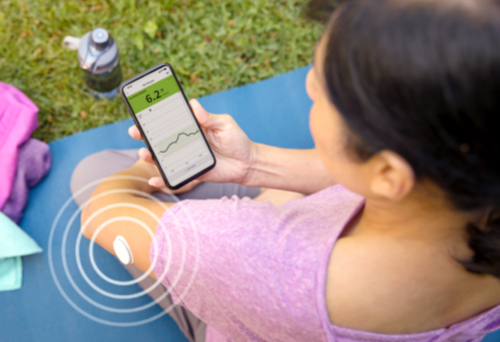Each of the patients below has an A1C of 7%, yet patients B and C are spending a lot of time outside of target range. A1C alone7 does not fully reveal glycemic patterns and trends.
With sensor-based glucose monitoring, it’s easy to see your patients’ hidden patterns and trends1.
A quick glance shows a patient’s current glucose reading, an 8-hour history, and a trend arrow indicating where their glucose is heading. By sharing their glucose data with you, you can see the bigger picture1.

Why sensor-based glucose monitoring?
Patient adherence to CBG (capillary blood glucose) is low2,3
Only 1/3 adhere to the frequency of CBG recommended by their HCP2
Almost 2/3 skip CBG because it is invasive to their lives3
Almost 2/3 skip CBG because it is invasive to their lives3
Many patients fail to achieve their optimal glycemic control2, 4, 5
<1/4 of patients using insulin achieve their A1C target of <7%4,5
Almost 40% of Canadians living with diabetes do not achieve their A1C target of ≤7%6
Infrequent glucose testing leads to insufficient glucose data for diabetes treatment decisions
Whether patients meet A1C goals or not, they may experience significant time outside of target range.7
Patient A
Patient B
Patient C
Above Target Range
(hyperglycemia)
In Target Range
Below Target Range
(hypoglycemia)
For illustrative purposes only. Not actual patient data.
International consensus recommendations set clear targets for Time in Range
Recommended Time in Range for all non-pregnant adults with T1D or T2D7
The consensus data recommend that adult patients with T1D or T2D spend >70% of their Time in Range (3.9-10.0 mmol/L).7
Increase Time in Range. Improve patient outcomes.8
International consensus demonstrates increased Time in Range results in decreased A1C8. An increase in Time in Range of 10% corresponds to a decrease in A1C of approximately 0.8%.8
Decreased Time in Range is associated with an increased risk of microvascular complications.9 With every 10% decrease in Time in Range, there is an increased risk of retinopathy and microalbuminuria.9
The FreeStyle Libre 2 system reveals a complete picture1 with a quick glance
Unlike traditional glucose monitoring, sensor-based glucose monitoring provides information about current glucose level, trend, rate of change of glucose and glucose levels from the past 8 hours.
For illustrative purposes only. Not actual patient data.
The use of finger prick testing10 or A1C alone11 does not fully reveal glycemic trends or glucose highs and lows. With the FreeStyle Libre 2 system, it’s easy to see your patients’ hidden glucose patterns.1
* Includes percentage of values > 13.0 mmol/L
The FreeStyle Libre 2 app is only compatible with certain mobile devices and operating systems. Please check our website for more information about device compatibility before using the app. Use of FreeStyle Libre 2 app requires registration with LibreView.
References:
- Unger J, Kushner P, Anderson JE. Practical guidance for using the FreeStyle Libre flash continuous glucose monitoring in primary care. Postgrad Med 2020;132(4):305-13
- Vincze G, et al. Factors associated with adherence to self-monitoring of blood glucose among persons with diabetes. Diabetes Educ 2004;30(1):112-25.
- Wagner J, et al. Invasiveness as a barrier to self-monitoring of blood glucose in diabetes. Diabetes Technol Ther 2005;7(4):612-19.
- Foster N, et al. State of type 1 diabetes management and outcomes from the T1D exchange in 2016-2018. Diabetes Technol Ther 2019;21(2):66-72.
- Brixner D, et al. Clinical and Economic Outcomes of Patients with Type 2 Diabetes on Multiple Daily Injections of Basal-bolus Insulin (MDI) Therapy: A Retrospective Cohort Study. Clin Ther. 2019;41(2):303-313.e1.
- Diabetes Canada. A snapshot of management in Canada. Accessed June 12, 2023. https://www.diabetes.ca/about-diabetes/stories/a-snapshot-of-diabetes-management-in-canada.
- Battelino T, et al. Clinical targets for continuous glucose monitoring data interpretation: recommendations from the international consensus on Time in Range. Diabetes Care 2019;42(8):1593-603.
- Vigersky RA, McMahon C. The relationship of hemoglobin A1C to Time in Range in patients with diabetes. Diabetes Technol Ther 2019;21(2):81–5.
- Beck RW, et al. Validation of Time in Range as an outcome measure for diabetes clinical trials. Diabetes care 2019;42(3):400-05.
- Janapala RN, et al. Continuous glucose monitoring versus self-monitoring of blood glucose in type 2 diabetes mellitus: a systematic review with meta-analysis. Cureus 2019;11(9):e5634.
- Hirsch IB, et al. Using flash continuous glucose monitoring in primary practice. Clin Diabetes 2019;37(2):150-61.


